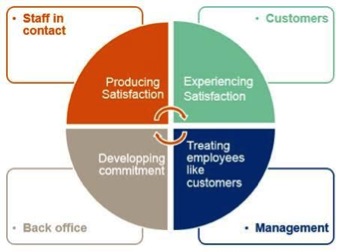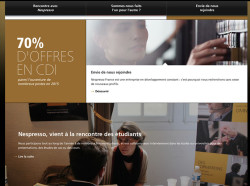The building blocks of a customer-centric approach are generally thought to include being accessible, responsive, empathic, collaborative and ‘putting the customer’s best interests first’. Claire Bonniol tells how to go beyond that culture and uses examples of brands that are ‘doing it right’ to show what great customer service looks like.
Claire Bonniol shares her customer service expertise.
As a customer service consultancy and think tank for many international companies, we get incredible insight into the differences in customer service culture around the world. There is a general consensus about what defines bad service – consumers being let down, organisations struggling to meet expectations and failures in products or service.
But what constitutes good service culture? The business adage ‘customer first’ is a useful starting point. The building blocks of a customer-centric approach are generally thought to include being accessible, responsive, empathic, collaborative and ‘putting the customer’s best interests first’.
However, service culture extends beyond just a customer-orientated approach, focusing instead on relationships and processes that are both external (involving clients) and internal (involving employees and managers). As academic studies have established, organisations that champion service culture empower employees, exceed customer expectations and set their sights not only on quality outcomes in terms of product quality, service quality and image, but also market performance (customer loyalty, customer satisfaction and repeat business).
Top tips:
- Make tangible the intangible – send the client or customer tangible evidence of change, professionalism and service straight away. The customer must perceive that things are happening.
- Stick to one’s promises – if a company is sincere in what it says and how it says it, customers will feel it because employees believe it.
- Personalise the service – use human contact to encourage brand loyalty.
- Draw on customers’ needs and feedback to shape a product.
- Aim at a long-term relationship with customers.
The Three As of customer service
There are three brands that, in my opinion, have come to symbolise what we aspire to in terms of customer service.
- Apple has managed to become the largest company in the world through the magic of its brand, the innovation in its design, but crucially it is also the customer service and the store as a place of experience and aspiration that makes it so successful.
- Amazon is the pioneer of online shopping and has set the standard for our expectations all over the world. It leads the way due to its investment in logistics and efficiency, but its focus on customer service is unparalelled through its user-friendliness, large choice and the trust that it places in the customer with its policy of reimbursing before investigating when there is a problem.
- Accor was the first European hospitality brand and has led the way in service culture innovation for 40 with a focus on training for its employees and managers in the values of the brand.
If high-quality service relies on staff attitudes towards customers, then it follows that employers must regard their employees as being just as important as the clients they serve. This principle of ‘consideration symmetry’ (originally developed and registered as a trademark by Academie du Service in France as Symetrie des Attentions) asserts that the quality of the relationship between a firm and its customers is equal to that between the firm and its employees.
Consideration Symmetry

Companies that enable their employees to use their initiative, for example, already possess the foundations needed to develop consideration symmetry.
Offering employees some autonomy helps create high quality customer service – every employee has to figure out what is right for each customer interaction in the context of their own role in creating an exceptional, meaningful and positively memorable customer experience.
Service culture is vital in the context of today’s world of social networks and digital technologies. Estimates suggest that by 2020 there will be at least 50 billion and possibly 100 billion connected devices around the world. Combine our global networked society with the fact that social media has made it easier to publicly and instantly broadcast customer experiences – good or bad – and the role of service culture is put into sharp focus.
Social media empowers consumers, enables more direct contact with brands and demands a more personalised approach to how customers interact with companies.
One of the biggest barriers to large global organisations trying to embed a strong service culture is that the approach demands flexibility and personalisation in the treatment of both employees and clients. Flexible, personalised delivery of services can be at odds with traditional business structures, cultures, rules and regulations. Building long-term brand loyalty through great customer service can be an intangible concept when top management’s vision is set on quick-win profits.
A successful customer service strategy can be defined by 5 rules:
- prioritise employees over the product;
- seek 100% customer satisfaction over zero errors;
- implement a service culture based on listening, understanding and acknowledgement when at fault;
- implement consideration symmetry at all levels of the organisation;
- encourage employees to develop autonomy and take initiative.
The diversity of these five shows that service is not just about customer service employees and can involve a need for change more deeply within company.
So, for those at the front line of customer service and marketing what are the practical steps to be taken? As a marketer one needs to check the system is balanced between employees and customers.
Follow the Three Bs:
- Be customer and employee centric (check that all of your decisions have a positive impact on both)
- Benchmark outside the industry
- Be customer-orientated towards your colleagues and engender good practice.
While it may sometimes seem that it is not the most direct route to profitability, adopters of consideration symmetry have shown that the quality of the professional experience of the employees has a real impact on customer satisfaction which ultimately results in a strong positive financial impact. One of the most high profile advocates is Vineet Nayar, CEO of HCL Technologies, one of the largest I.T. outsourcing firms in the world, who even wrote a book called ‘Employees First, Customers Second’.
Consider Zappos, known as a guru in customer service and now a subsidiary of Amazon. They give their call centre employees a high level of autonomy in satisfying customers as this garners the best results. They even counter-intuitively reward employees for long conversations with customers – the recent record being set at 10 hours, 43 minutes! While not every company would benefit from quite such an extreme incentivisation, it is a pioneer in the change of attitude towards customer service in the digital age.
Developing an overarching service culture enables managers and marketers to establish clear and consistent expectations about standards of service. This is particularly important for global companies, in order to prevent inconsistencies across the different markets.
Case Study: Nespresso

Nespresso is the global pioneer in high quality capsule coffee. Also a leader in excellent customer service its current initiatives include:
- Aligning all channels (store, club, internet) so there is a comprehensive approach to customers’ experience
- Developing the employee experience at the same time. Check out its French careers website as an example of best practice
- Increasing corporate social responsibility and developing recycling solutions
Case Study: Essilor
Essilor is the world leader in corrective contact lenses, with the mission to ‘improve lives by improving sight’. Customer service has been a key to their success since 2006, with a large-scale international customer services training programme for its factories. As a result, despite the global and highly technical nature of the business, they achieved:
- over 85% very satisfied and completely satisfied customers after changing the KPIs to be more customer oriented (eg. prioritising date of arrival at client over date of shipping)
- 100% customer satisfaction after complaint resolution
- 50% reduction in time to resolve a problem
These extremely high scores reflect a company where large proportion of staff are shareholders in the company and therefore have a stake in its success.
Read also:
Personalisation as a marketing tool: what do brands need to know?
Your customer service opportunity might be knocking: be ready!










Leave your thoughts